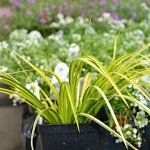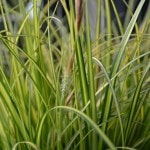Carex (Sedge)
Carex or carex grass, also known as Japanese sedge, offers a unique texture and visual appeal to any garden or landscape. Carex grass is highly versatile and can be used in various ways to enhance your outdoor space.
Note that the term “carex” is often used interchangeably with “carex grass” and “sedge”; however, they have specific meanings. Carex or carex grass is a specific subset of sedges, whereas sedge is a general term that includes carex and other varieties in the Cyperaceae family. In simpler terms, all carex are sedges, but not all sedges are carex.
Despite its many names, carex is an ornamental grass-like plant that thrives in a variety of conditions, making it an adaptable addition to your landscaping!





